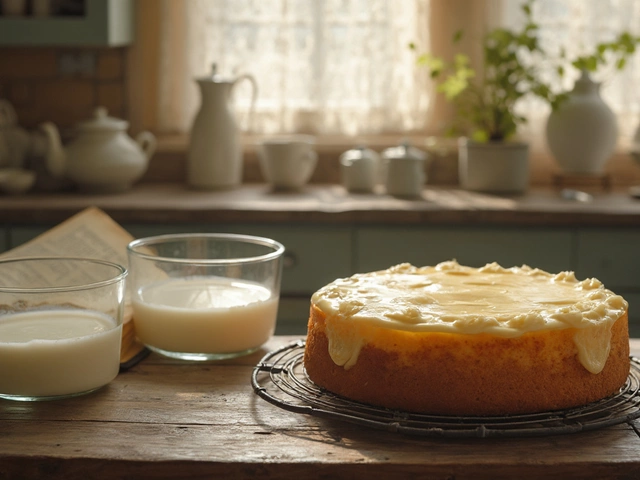
So you’re craving tiramisu but you want to get that dreamy, gooey texture just right. Before you grab whatever’s in the fridge, let’s settle the battle: prato or mozzarella—who does the better melt?
These cheeses might look similar at first glance, but they behave completely differently when heat gets involved. Maybe you’ve seen mozzarella bubble and stretch on pizza, while prato just kind of goes soft without the drama. That’s not a coincidence. Knowing what sets these two apart isn’t just some foodie trivia—it actually changes the end result of your dish.
If you want that smooth, consistent texture in desserts like tiramisu or even in savory baked goods, picking the right cheese saves you from a grainy mess or a rubbery finish.
- Prato vs. Mozzarella: The Basics
- How Each Cheese Melts
- Best Cheese Choice for Tiramisu
- Other Great Uses for Prato and Mozzarella
- Tips for Perfect Cheese Melting
Prato vs. Mozzarella: The Basics
Let’s break it down. Prato cheese is popular in Brazil, kind of like a milder cheddar with a smooth, slightly yellow texture. It’s super versatile, but it melts in a way that’s more subtle, not stringy. Now, mozzarella needs no intro: it’s the classic pizza topper, famous for those long, oozy cheese pulls. Fresh or low-moisture, it’s always soft, mild, and melts like a dream.
Here’s a quick head-to-head:
| Cheese | Country of Origin | Texture | Typical Use |
|---|---|---|---|
| Prato | Brazil | Semi-soft, smooth | Sandwiches, casseroles |
| Mozzarella | Italy | Soft, stretchy (especially fresh) | Pizza, lasagna, tiramisu |
The real difference is how their proteins and moisture behave with heat. Mozzarella’s stretchy magic comes from its high moisture and special protein structure from the pasta filata method—basically, it gets kneaded in hot water to make it elastic. Prato doesn’t go through this, so it’ll melt but not stretch or pull.
Here’s what cheesemonger Mariana Dias says about picking between them:
“If you want a melt that’s creamy and holds together, go with prato. For a gooey, super stretchy finish, it has to be mozzarella.”
So, if you’re thinking about texture and flavor for your dish, don’t just swap them out. They each do their own thing best, and it’s worth knowing which gives you the results you’re after.
How Each Cheese Melts
Let’s cut straight to what actually happens when you heat these two cheeses. Prato and mozzarella melt in totally different ways, and that can make or break your dessert or that panini you've been dreaming about.
First up, mozzarella. This cheese is famous for its stretchy, elastic melt. That signature cheese pull you see on pizza commercials? That's all mozzarella. It has a high moisture content and a lot of protein, so as it heats, it forms long, gooey strands. It gets super melty fast but firms back up as it cools, which is why it’s perfect for hot dishes eaten straight out of the oven.
Prato cheese, though, acts differently. It's softer and melts more evenly and quietly, almost like a thick sauce. It doesn’t stretch like mozzarella. Instead, it goes creamy and smooth, so you don’t get those long chewy pulls. This makes prato a secret weapon for recipes where you want a velvety cheese layer—think baked goods or even a twist on tiramisu where you need something that blends in easily and doesn’t overpower other ingredients.
One thing to note with both: temperature matters. Mozzarella likes high heat to really show off its stretch. Prato, on the other hand, melts evenly at a gentler heat and can break or get oily if you really blast it. So, for any cheese melt moment, keep an eye on your oven or pan and don’t expect the same results from both types.
Quick tip: If you want to test which melts better for your recipe, do a small batch. Heat both varieties side by side and check the texture after a few minutes. You’ll notice mozzarella bubbles and strings, while prato forms puddles and stays soft. Picking the right one depends on whether you’re after stretchy or creamy.

Best Cheese Choice for Tiramisu
Alright, let’s get real: when it comes to tiramisu, the cheese you use can make or break your dessert. Most traditional recipes actually call for mascarpone, not prato or mozzarella. But sometimes, you’re working with what’s in your fridge or local store, so let’s talk about how prato and mozzarella stack up in a pinch.
Mozzarella is famous for its melt—think pizza—soft, stretchy, sometimes stringy. But that’s exactly why it doesn’t shine in tiramisu. You don’t want strings or chewiness in a creamy dessert. Even the softer, fresh mozzarella tends to separate into little lumps when whipped or mixed cold, which just feels weird in a tiramisu layer.
Prato, on the other hand, is a Brazilian cheese that’s milkier and softer than most, and it melts easier than hard cheeses. But it still doesn’t get that silken, almost buttery smooth texture you’re looking for in classic tiramisu. If you swap mascarpone for prato, you’ll get a firmer, heavier cream, maybe a tiny bit grainy if you’re not careful. Flavor-wise, prato is also a bit saltier and more savory than mascarpone, which can mess with the sweet, coffee-flavored layers of tiramisu.
If you really have to pick between the two, prato is less of a disaster than mozzarella because it at least blends better. But honestly, neither is ideal. Here’s how they stack up:
| Cheese | Melt Texture | Suits Tiramisu? | Flavor Impact |
|---|---|---|---|
| Prato | Soft, dense, not silky | Better than mozzarella, but not perfect | Mild, a bit salty, can overwhelm dessert |
| Mozzarella | Stringy, stretchy, separates easily | No, ruins creamy texture | Mild, but texture is a dealbreaker |
So what’s the move if you’re stuck with just prato or mozzarella in your kitchen?
- If you must use prato, mix it with a bit of cream or Greek yogurt to lighten the texture and smooth things out. Beat until you get the softest consistency possible.
- Skip mozzarella unless you’re absolutely desperate; even then, expect a far-from-authentic result.
- If you’re able, buy mascarpone or at least blend ricotta and cream cheese together for a closer homemade swap.
Bottom line: Neither prato nor mozzarella is a perfect fit for tiramisu, but prato is slightly closer. Still, your tiramisu will be a bit unconventional compared to the traditional dessert people rave about. Whenever possible, grab mascarpone for that authentic, silky finish everyone craves.
Other Great Uses for Prato and Mozzarella
Both prato and mozzarella are way more versatile than just being a topping for pizza or lasagna. Each brings something unique to the table—literally—and swapping them can totally change your recipe’s vibe.
Starting with prato cheese (the keyword!), this cheese is a real go-to for grilled sandwiches. Because it melts evenly and gets super creamy, it’s tough to beat in a classic grilled cheese or on hot sandwiches like a melt. Prato also holds its shape just enough, so it doesn’t just run out of your sandwich and disappear. When used in casseroles, prato gives you that smooth, even cheese layer people love.
Mozzarella, on the other hand, is the star for when you want cheese pulls and a stretchy finish. That explains why it dominates pizza joints everywhere. It’s also the top pick for baked pastas (like baked ziti), stuffed crusts, and homemade cheese sticks. Fresh mozzarella can even make salads like caprese feel special, thanks to its soft bite and gentle taste.
Both cheeses work in snacks and starters too. Here are practical ways you can use these cheeses:
- Prato: Panini, cheese breads, savory pies, and topping for oven-baked potatoes.
- Mozzarella: Lasagnas, quesadillas, stuffed chicken, or cut up for antipasto platters.
Check out these quick stats that show how each cheese stacks up for common kitchen uses:
| Use Case | Prato | Mozzarella |
|---|---|---|
| Grilled sandwiches | Excellent | Good |
| Baked casseroles | Very good | Good |
| Melty cheese pull | Okay | Excellent |
| Caprese salad | Not common | Perfect |
| Stuffed chicken | Decent | Best |
If you’re feeling adventurous, try prato in places you’d usually drop cheddar, especially in cheesy breads or creamy sauces. For party snacks, switch up your cheese board by adding slices of both and let people taste the difference. This hands-on taste test can help you figure out what melts and tastes best for your cooking style.

Tips for Perfect Cheese Melting
Getting the melt just right isn’t luck. Temperature, cheese prep, and even fat content play a role. Here’s how you nail it every time—whether you pick prato or mozzarella.
- Shred or slice thinly: Cheese melts faster and smoother when it’s cut small. Big blocks melt unevenly and can go stringy or greasy.
- Room temperature is your friend: Cold cheese straight from the fridge doesn't melt evenly. Give it 15-20 minutes on the counter first.
- Go slow with heat: High heat can make cheese tough or oily. Low and slow gets you that stretchy or creamy melt. On the stove, stick to medium or lower. In the oven, 180°C (350°F) is the sweet spot.
- Add a splash of dairy: In sauces or desserts, mixing in milk or cream stops cheese from clumping together and keeps things silky.
- Stir, don’t beat: If you’re melting cheese into a mix or sauce, gentle stirring keeps things smooth. Vigorous whisking can break the emulsion and ruin the texture.
Check out this cheat sheet with basic melting stats to keep you one step ahead:
| Cheese | Ideal Melting Temp | Melting Texture | Best For |
|---|---|---|---|
| Prato | 60°C (140°F) | Soft, creamy | Sandwiches, soufflés, desserts |
| Mozzarella | 65°C (150°F) | Stretchy, stringy | Pizza, lasagna, tiramisu |
If you notice oil pooling or a weird rubbery layer, your pan’s probably too hot. Take it off the heat quick and try gently folding the cheese or add a bit more milk. These little tweaks usually rescue things before they go too far.
Perfect cheese melting is one of those kitchen flexes that pays off every single time. Keep these tips handy, and you won’t have to second guess your cheese game again.









Write a comment